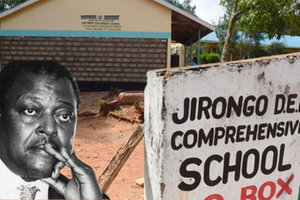Premium
Uhuru orders Magoha to release 2021 school calendar in 2 weeks

Education CS George Magoha addresses members of the National Commission for Science,Technology and Innovation at Pride Inn Hotel in Mombasa on November 9.
What you need to know:
- While schools are affected by the Covid-19 pandemic, the President said the government would ensure no child suffers.
The government will expand infrastructure in schools in the coming two years to address the perennial problem of congestion, the President said.
President Uhuru Kenyatta has directed Education Cabinet Secretary George Magoha to release the 2021 school calendar.
While schools are affected by the Covid-19 pandemic, the President said the government would ensure no child suffers.
“I direct the Ministry of Education to issue a full school calendar for 2021 within 14 days,” Mr Kenyatta said when he delivered the State of the Nation address yesterday.
He, however, said learners in Grade Four, Standard Eight and Form Four would remain in school.
“No child will be left behind. That includes those who have transitioned to young parenthood during this period,” he said.
Prof Magoha is expected to call a stakeholders’ meeting on salvaging the 2020 academic calendar next week.
“As a parent and grandfather, I feel the pain of children remaining at home for a year,” the President said, adding that the government would ensure education is reformed.
Supplied textbooks
He said the gradual replacement of the 8-4-4 system with the competency-based curriculum (CBC) would succeed, with Grade Five expected to be rolled out next year.
The government has supplied textbooks to learners in Grades One to Three at a ratio of 1:1.
The programme will be extended to subsequent CBC classes, he said.
President Kenyatta added that 430,598 students have been enrolled in technical and vocational education and training (TVET) institutions.
He said curricula for the TVETS have been developed in collaboration with industry players to make the training relevant to market needs.
The government will expand infrastructure in schools in the coming two years to address the perennial problem of congestion, the President said.
The expansion will be financed by the Ministry of Education, devolved governments and the National Government Constituency Development Fund (NG-CDF).
It is expected that 12,500 classrooms will be built across the country.
Congestion in schools was exacerbated by the 100 transition from primary to secondary school policy introduced by the government two years ago.
Infrastructural gap
Facilities in almost all secondary schools are stretched.
According to the 2020 Economic Survey, Kenya has 23,286 public primary and 8,933 secondary schools.
“Infrastructure in our schools is deteriorating but this should motivate us to work harder,” the President said.
“Through NG-CDF, we will address the infrastructural gap.”
Mr Kenyatta directed the ministries of Education and Transport, Infrastructure, Housing and Urban Development to develop guidelines on cost-effective buildings for schools by December 1.
“The next frontier in providing quality education is physical structure and content,” he said.
Lack of or rundown facilities is one of the greatest challenges to social distancing and observing the Covid-19 protocols.
Apart from congestion, schools lack clean running water and storage tanks.
While reading the budget in June, Treasury Cabinet Secretary Ukur Yatani said Sh2.1 billion would be used to fund the construction of additional classrooms in secondary schools.






